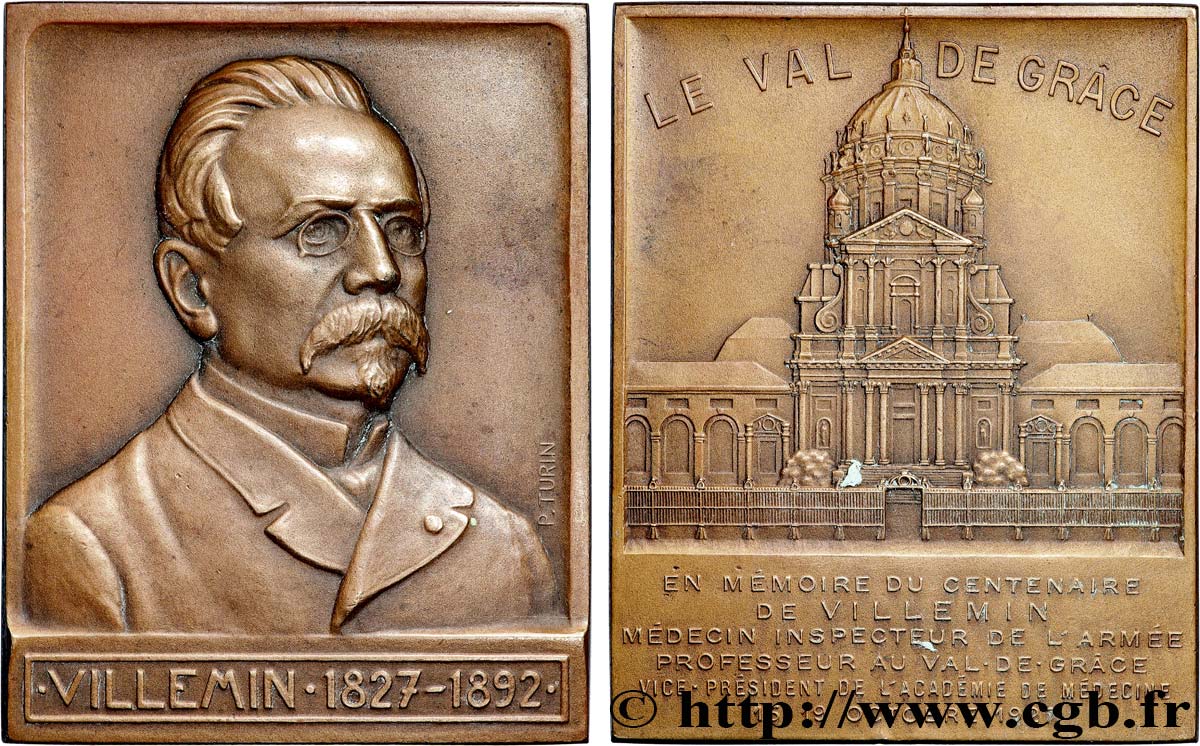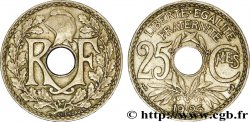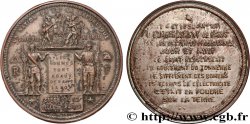fme_897950 - III REPUBLIC Plaquette, Centenaire du Docteur Villemin
50.00 €(Approx. 52.50$ | 41.50£)
Quantity
Add to your cart

Type : Plaquette, Centenaire du Docteur Villemin
Date: 1927
Mint name / Town : 75 - Paris
Metal : bronze
Diameter : 59,5 mm
Orientation dies : 12 h.
Engraver TURIN Pierre (1891-1968)
Weight : 72,20 g.
Edge : lisse + Triangle BRONZE
Puncheon : Triangle BRONZE
Coments on the condition:
Patine hétérogène, présentant quelques points d’usure sur les hauts reliefs. Présence de quelques coups
Obverse
Obverse legend : VILLEMIN. 1827-1892..
Obverse description : Buste à droite du docteur Villemin, signé : P. TURIN.
Reverse
Reverse legend : LE VAL DE GRÂCE // EN MÉMOIRE DU CENTENAIRE / DE VILLEMIN / MÉDECIN INSPECTEUR DE L’ARMÉE / PROFESSEUR AU VAL DE GRÂCE / VICE PRÉSIDENT DE L’ACADÉMIE DE MÉDECINE / 15-19 OCTOBRE 1927.
Reverse description : Vue du Val de Grâce ; légende au-dessus et en six lignes à l’exergue.
Commentary
Dimensions : 59,5*47 mm.
Jean-Antoine Villemin, né à Prey dans les Vosges le 25 janvier 1827 et mort à Paris le 3 octobre 1892, est un médecin militaire, hygiéniste et épidémiologiste français, connu pour avoir démontré en 1865 que la tuberculose était une maladie contagieuse.
Il fait ses études de médecine à l'École de médecine militaire de Strasbourg et obtient son diplôme de médecin militaire en 1853, puis il exerce et enseigne à l'hôpital militaire du Val-de-Grâce à Paris. En 1874, il est élu membre de l'Académie de médecine, dont il est vice-président en 1891.
Dans les années 1860 il remarque que les soldats confinés dans les casernes sont davantage atteints de tuberculose que ceux en campagne1. Il démontre que la tuberculose est une maladie transmissible en inoculant des lapins de laboratoire avec du matériel provenant d'êtres humains ou de têtes de bétails contaminés. Il publie ses résultats dans un ouvrage intitulé Études sur la Tuberculose, où il décrit la transmission de la tuberculose de l'homme vers les lapins, du bétail vers les lapins, et entre lapins. Ses découvertes sont cependant ignorées par la communauté scientifique et on ne se souviendra de sa contribution que des années plus tard, lorsque ses résultats seront corroborés par les travaux d'autres scientifiques.
.
Jean-Antoine Villemin, né à Prey dans les Vosges le 25 janvier 1827 et mort à Paris le 3 octobre 1892, est un médecin militaire, hygiéniste et épidémiologiste français, connu pour avoir démontré en 1865 que la tuberculose était une maladie contagieuse.
Il fait ses études de médecine à l'École de médecine militaire de Strasbourg et obtient son diplôme de médecin militaire en 1853, puis il exerce et enseigne à l'hôpital militaire du Val-de-Grâce à Paris. En 1874, il est élu membre de l'Académie de médecine, dont il est vice-président en 1891.
Dans les années 1860 il remarque que les soldats confinés dans les casernes sont davantage atteints de tuberculose que ceux en campagne1. Il démontre que la tuberculose est une maladie transmissible en inoculant des lapins de laboratoire avec du matériel provenant d'êtres humains ou de têtes de bétails contaminés. Il publie ses résultats dans un ouvrage intitulé Études sur la Tuberculose, où il décrit la transmission de la tuberculose de l'homme vers les lapins, du bétail vers les lapins, et entre lapins. Ses découvertes sont cependant ignorées par la communauté scientifique et on ne se souviendra de sa contribution que des années plus tard, lorsque ses résultats seront corroborés par les travaux d'autres scientifiques.
.








 Report a mistake
Report a mistake Print the page
Print the page Share my selection
Share my selection Ask a question
Ask a question Consign / sell
Consign / sell
 Full data
Full data









